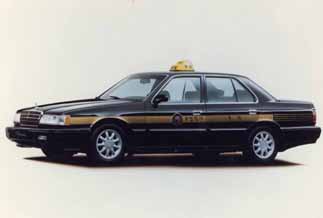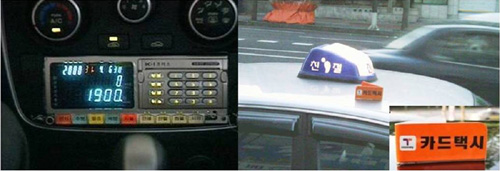Tips for that next taxi trip in Seoul

Images of a deluxe, or “mobeom” taxi
In fact, according to a 2008 survey conducted by the Korea Tourism Organization, 55 out of 276 complaints filed with the organization by foreigners visiting Korea last year were about local taxi services, accounting for 20 percent of the total, with communication problems and some taxi drivers’ riding the arm cited as the main reasons.

A regular, or “ilban” taxi. [JoongAng Ilbo]
What kinds of taxis are available in Seoul?

At left, a photo of the meter inside a regular (“ilban”) taxi. The reading of “1900” indicates 1,900 won, the basic rate for a regular taxi ride. At right, the sign that confirms in Korean that a credit card can be used to pay the fare for the taxi concerned. Provided by Seoul Global Center
During the day, the basic rate is 1,900 won ($1.42) for the first two kilometers and 100 won for every 144 meters thereafter. As traffic in Seoul is frequent, if the taxi is traveling at a speed lower than 15 kilometers per hour, 100 won is added to the meter every 35 seconds. In addition, there is a 20 percent late-night surcharge that is added between the hours of midnight and 4 a.m. As for the mobeom taxi, the basic rate is 4,500 won for the first three kilometers, after which 200 won is charged for each 164 meters when the taxis is traveling faster than 15 kilometers per hour, otherwise 200 won is added for every 39 seconds when traveling slower than this speed. Mobeom taxis do not have an additional nighttime fee.
Passengers who are traveling in a large group or have excess baggage may choose to take a van taxi. These taxis have the same rate system as the mobeom taxis. They are available on call, and, depending on the company dispatched, a 1,000 won dispatching fee may apply.
In addition to these options, special taxis for foreigners will run in Seoul starting next month. Between 100 and 300 taxis of this type will be available at downtown centers like Gwanghwamun, as well as at Incheon International Airport. Fare rates will be similar to those of ilban taxis, but with a 20 percent surcharge. Flat rate fares will also be available. For example, for travel from the airport to Gwanghwamun, a flat rate of 65,000 won for ilban taxis and 95,000 won for mobeom taxis will apply. Also, there will be a 24-hour call center available to take requests for taxi dispatches in English and Japanese.
How do I know how much to pay? Can I pay with a card?
When riding in one of these taxis, the fare is displayed on the meter, and payment can be made either with cash or by card. It should be noted, however, that not all local taxis have credit card machines, and thus if a passenger is planning to pay by card, one should confirm that it is possible before taking the taxi. The above right photo shows a taxi with an orange sign that confirms in Korean that a card can be used to pay the fare.
Reading Korean, however, is not necessary, as all that needs to be recognized is that orange sign.
What about communication problems?
When you get into almost any taxi in Seoul, you will notice a sticker on the back passenger side door that reads “Free Interpretation.” By asking for this service in your cab, you will be connected via the taxi driver’s speaker phone with an interpreter who can speak your language. In addition to this number, the BBB (Before Babel Brigade) is another volunteer-based interpretation service available in Korea. The BBB can be reached at 1588-5644.
How can I call a taxi to pick me up?
To call a taxi, all that is required is the phone number of one of these services and the name (or description) of your location, and a taxi in your area can be dispatched to you. The major companies in Seoul include KindCall (1588-3382), NaviCall (1599-8255), NCall (1688-2255) and S Taxi (1577-0115). In general, when you call for a taxi you will have to pay a 1,000 won service charge, however if the fare comes out to over 10,000 won, the charge is waived.
Although none of these services are available in languages other than Korean, there are two methods to overcome this barrier if no Korean friends are available to call a taxi on your behalf. One is to ask one of the employees of an establishment you have recently patronized to call a taxi for you. This is often looked at as an extension of their customer service and they can direct the taxi as they are familiar with the area. The second method is to call one of the available help hotlines. The BBB, the volunteer phone interpretation service mentioned above, is available 24 hours a day at 1588-5644. Also available 24 hours a day is the tourism information hotline, accessible by dialing 1330.
In Korea, should you tip taxi drivers?
No, it is not customary to tip taxi drivers in Korea.
When I take a taxi, which seat should I sit in? Is it O.K. to sit next to the driver?
It is up to the passenger to decide in which seat he or she would like to sit. It should be noted that passengers in the front seat are required by law to wear their safety belts, whereas passengers in the back are not.
If I experience a problem taking a taxi, how can I report it?
If you experience price gouging, fare refusal or have been dropped off before reaching your final destination, the Dasan Call Center, available by dialing 120, accepts reports of such inconveniences. In order to report such problems, one must be aware of the taxi number. This can be difficult, as the number consists of several components: for instance, the word “Seoul” followed by two digits, then the Korean letters that spell either “a,” “sa,” “ja,” or “ba,” followed by four further digits. As this would be especially problematic for those who cannot read Korean, it is a good idea to habitually ask for receipts when paying, as the taxi number is automatically printed on the receipt.
For questions or comments on the Living in Korea column, please e-mail estyle@joongang.co.kr. Readers, particularly expats living in Korea, are also welcome to send suggestions for topics that they wish to be covered in this column, which has been devised to help expats adjust to life in Korea.










with the Korea JoongAng Daily
To write comments, please log in to one of the accounts.
Standards Board Policy (0/250자)